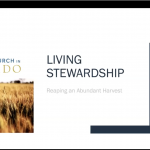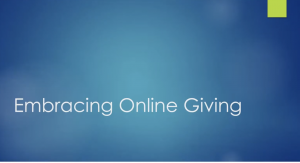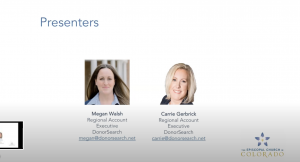Stewardship
What is Stewardship?
"When stewardship is understood as the right use of the resources God has given us, it touches all aspects of our lives," write Nancy David and Susan Elliott in More than an Annual Campaign. But oftentimes financial anxiety makes people see stewardship as an obligation rather than a life practice.
We hope in this space to begin a larger conversation about the spirituality of stewardship and the ways it forms us as disciples of Christ. At the same time we seek to support you in managing the practical demands of financial stewardship by providing best practices and resources for conducting meaningful and successful campaigns.
Recommended Stewardship Resources
Project Resource
Project Resource is an initiative by the Episcopal Church's College for Bishops designed to foster a culture of radical generosity and effective financial development within dioceses. It offers training for leaders to return to their dioceses equipped to teach and lead in fundraising, stewardship, and organizational change. The program includes resources for addressing societal shifts, leadership challenges, and creating tailored financial development plans. It aims to transform the culture and systems around financial stewardship in the Episcopal Church.
For more details and training opportunities, visit Project-Resource.org.
Stewardship 101
The video series Introducing Stewardship with Kristine Miller from ChurchNext provides an excellent introduction to stewardship, including best practices and common mistakes, and would be time well spent for any stewardship campaign chair or members of a stewardship committee. Allow 45 minutes to one hour.
Year-Round Stewardship
In his article Transformative Stewardship Calendars, Chris Harris writes, "At its heart, stewardship calls us to a lifetime of discernment around the following question: How do we steward (put to good use) the gifts we've been given in all their many forms to do the work that God has given us to do? Many, if not most, parishioners associate stewardship with the church's fall financial stewardship campaign. How can churches expand the meaning of stewardship and continue teaching about stewardship throughout the year? Chris Harris' article provides creative ways to incorporate stewardship teaching throughout all the seasons of the church year. Read more >
Theology of Money
How do we become good stewards of our financial resources? Even Jesus Needed Money by Dennis Maynard is an easy-to-read guide for congregations and families who are seeking a theology of stewardship–healthy, realistic practices around spending, saving, and giving. The book would be a great choice for a parent's forum and could be a recommended resource for individuals or families in need of financial guidance.
The article Dollars and Discipleship says "Stewardship is about using the gifts God gives us to do the work God calls us to do." How do we align our use of money with our theology and values? How can we shift from "transactional" to "transformational" giving in our churches?
Prayer
Prayer can help guide our practices in all things, including giving. The Episcopal Diocese of Washington has compiled a wonderful set of prayers around giving for adults, children, vestries, and congregations. Go to prayers >
Annual Stewardship Campaigns
Annual church stewardship campaigns are the primary way churches raise funds to pay for church operations and building maintenance. While these are key reasons for fundraising, regular stewardship campaigns serve the greater work of enabling churches to fulfill their missions and strive to toward their visions of building up God's kingdom. The stewardship resource New Consecration Sunday describes three types of giving in churches:
- Offerings only (no formal stewardship campaign) – Individuals typically give 1.5% of their income.
- Stewardship campaign with pledges – Individuals tend to give 2.9% of their income. Writing down financial commitments leads to a higher level of giving.
- Percentage contributions – Churches ask: What percentage of your income do you feel God calling you to give? On average, giving increases to 4.6% of income.
Does your church have an annual giving campaign? Have you discovered campaign strategies and/or best practices you would like to share? We would love to post them here.
Best Practices
Before you Begin
- Create an annual stewardship statement that reflects your church's mission and vision. Angela Emerson in Creating a Culture of Giving suggests considering the following questions as you write your stewardship statement:
- What do I believe about God and money?
- What am I committed to doing about making my faith and my relationship with God a more integral part of how I think and act about financial decisions?
- To what action, process, practice, and/or reflection do I want to invite our congregation?
The resulting three-part statement leads with the statements, "We believe," "We commit," and "We invite." Read more about process for developing a statement >
- Show (preach, teach) how giving supports your congregation's internal and external ministries.
- Have a plan. Create a timeline for your campaign, including follow-up.
- Decide who will do what and make sure your campaign team has the training it needs before you begin.
- Document campaign goals. Will the campaign fund operations or ministry initiatives as well?
- Be (or become) comfortable talking about money.
- Set up multiple ways to give: envelopes, electronic funds transfer, website, text, stock transfer. Different people and different generations of people will have preferred ways to give. Provide clear instructions for each.
In the Beginning
- Have a set start (kick-off) to your campaign. Support from clergy and leadership should be visible.
- Send each parishioner a letter describing the campaign and how it works. Include your stewardship statement, campaign theme, and campaign goals. Consider adding a personal note.
- Give thanks! Be sure your campaign is joyful and celebratory. This is a time to give thanks for the blessings in individual lives and the life of the parish.
Throughout the Campaign
- Celebrate the mission and ministry of your church.
- Have parishioners give personal testimonials about how the church or a particular ministry has impacted their lives.
- Be transparent about church finances, including the annual budget, campaign goals, and how people's gifts will be used.
- Give thanks!
At the End
- Have an ingathering of pledges on the final Sunday of the campaign. Be sure you have communicated information about the ingathering.
- Give thanks – for the church; the members, visitors, and guests; the financial gifts; and the work to be done in the year ahead! Have a celebratory brunch or special coffee hour.
- Send thank you letters to each person who has pledged.
- Follow up personally with individuals who have not pledged.
During the Year Ahead
- Send regular statements to each person who has pledged. Statements ensure transparency and serve as a reminder to pay pledges.
What to Do When Pledges Fall Short
Not every stewardship campaign is successful, but there are concrete things you can do to understand why, regroup, make up budget differences, and plan for a more successful campaign next year. Read more now >
Past Webinars
 Living Stewardship
Living Stewardship
Audience: stewardship committees, clergy, senior wardens, treasurers
Objective: Help churches navigate stewardship in the new era of hybrid church.
Presenters: Paul Alexander, Missioner for Development and Financial Stewardship and Tracy Methe, Coordinator for Development and Faith Formation
View webinar recording >
View PowerPoint Slides >
View workshop recording (introduction and conclusion; small groups not recorded) >
 Embracing Online Giving
Embracing Online Giving
Audience: stewardship committees, clergy, senior wardens, treasurers
Objective: Help equip churches to implement online giving
Guest panelist: Mary Ann Ryan. Mary Ann Ryan is a member of St. Stephen's, Longmont, where she also serves on the vestry and is the treasurer. Mary Ann retired from IBM in 2017, after 35 years of service. She has her B.A. in Engineering & Computer Science, and spent most of her time in IBM managing large-scale projects. She has been fortunate enough to travel the world both professionally and personally, and spent 2 years on assignment in London managing IBM Europe's largest Artificial Intelligence project. She enjoys arts and crafts projects of any kind, and she spends her retirement "giving back" her many blessings by regularly volunteering at the local homeless shelter, a local youth empowerment camp, the Boulder County Jail, and Junior Achievement.
View webinar recording >
 Increasing Giving withDonor Analytics
Increasing Giving withDonor Analytics
Audience: Stewardship and capital campaign committees, clergy, senior wardens, treasurers
Objective: Help congregations understand how donor analytics work and how they can be used in churches to identify giving potential and increase giving
Guest panelist: Carrie Gerbrick and Megan Walsh from DonorSearch
View webinar recording >

Building Community with Church Management Software
Audience: clergy, parish administrators, senior wardens
Objective: Share how good church management software can support ministry, improve communications, provide record-keeping, and build community.
Guest panelist: Rebekah Musick and Trey McDonald from ACS Technologies
View webinar recording >
Fall 2018 Webinars
